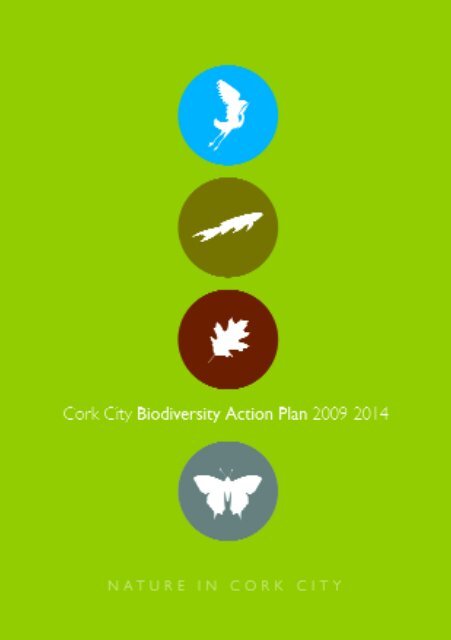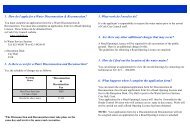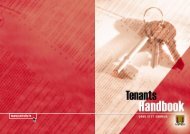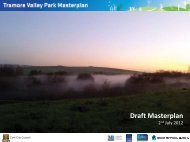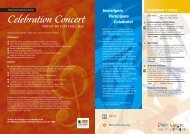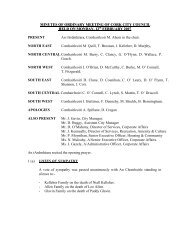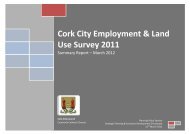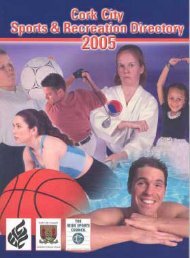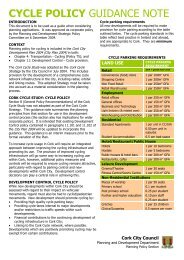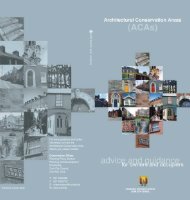Cork City's Biodiversity Action Plan - The Heritage Council
Cork City's Biodiversity Action Plan - The Heritage Council
Cork City's Biodiversity Action Plan - The Heritage Council
Create successful ePaper yourself
Turn your PDF publications into a flip-book with our unique Google optimized e-Paper software.
ForwordMessage from the Lord MayorIam delighted to introduce the first ever <strong>Biodiversity</strong> <strong>Action</strong> <strong>Plan</strong> for <strong>Cork</strong>City. <strong>The</strong> <strong>Cork</strong> City <strong>Biodiversity</strong> <strong>Action</strong> <strong>Plan</strong> identifies the amazingwealth of wildlife and nature that exists in <strong>Cork</strong> City. <strong>The</strong> plan also setsout actions to raise awareness and help to protect and enhance <strong>Cork</strong>City’s natural heritage.Cllr. Brian BerminghamLord MayorI would like to acknowledge the hard work of the <strong>Cork</strong> City <strong>Biodiversity</strong>Working Group, Dr. Lesley Lewis consultant, the <strong>Cork</strong> City <strong>Heritage</strong>Officer Ms Niamh Twomey and all those who gave their time and energyto producing this document. I look forward to the implementation of theactions in this <strong>Biodiversity</strong> <strong>Action</strong> <strong>Plan</strong> over the next five years.Message from ManagerIwelcome the production of the <strong>Cork</strong> City <strong>Biodiversity</strong> <strong>Action</strong> <strong>Plan</strong> 2009-2014. <strong>The</strong> <strong>Plan</strong> provides for practical action for the care andmanagement of <strong>Cork</strong> City’s natural heritage. I believe that this in turn willimprove the quality of life for those living, working and visiting the City.Mr Joe GavinCity Manager<strong>The</strong> development of this <strong>Plan</strong> marks the culmination of a lot of hard workand co-operation by many individuals and groups. I would like tocongratulate and commend all those involved in the development of thisplan. I look forward to the implementation of the plan and to seeing manysuccessful projects over the coming years.Acknowledgements<strong>Cork</strong> City <strong>Council</strong> would like to thank the participants on the <strong>Biodiversity</strong> Working Groupand Dr. Lesley Lewis (plan consultant) for their contributions to the development of the<strong>Cork</strong> City <strong>Biodiversity</strong> <strong>Action</strong> <strong>Plan</strong>.<strong>Cork</strong> City <strong>Council</strong> wish to acknowledge the role of the <strong>Heritage</strong> <strong>Council</strong> in initiating the<strong>Biodiversity</strong> <strong>Action</strong> <strong>Plan</strong> in association with <strong>Cork</strong> City <strong>Council</strong> and in particular the fundingreceived from the Department of the Environment, <strong>Heritage</strong> and Local Government..<strong>Cork</strong> City <strong>Council</strong> also wishes to thank all those who participated in the development ofthis plan through the provision of information or by making observations.Thanks also to the following people who kindly contributed images for the plan:Mr Denis MacGarry, Mr Jim Wilson (www.irishwildlife.net), Mr Tony O Mahony, Dr PadraigWhelan, Mr Conor Kelleher, <strong>Cork</strong> County Bat Group, Dr. Michelle Cronin, Coastal MarineResource Centre (CMRC) and <strong>The</strong> Dept of Environment, <strong>Heritage</strong> and Local Government.COMHAIRLE CATHRACH CHORCAÍCORK CITY COUNCILBlue Tit (Parus caeruleus) in car side view mirror
ContentsIntroduction - <strong>The</strong> Importance of <strong>Biodiversity</strong> 1What is <strong>Biodiversity</strong>? 1<strong>Cork</strong> City’s Unique Natural <strong>Heritage</strong> 1Why is <strong>Biodiversity</strong> important? 2Legislative Background 2Principal National and International Legislation 3Why does <strong>Cork</strong> City need a Local <strong>Biodiversity</strong> <strong>Action</strong> <strong>Plan</strong>? 4Aims and Objectives of the <strong>Cork</strong> City <strong>Biodiversity</strong> <strong>Action</strong> <strong>Plan</strong> 5<strong>Cork</strong> City’s <strong>Biodiversity</strong>- An Overview 7Designated sites for Nature Conservation within <strong>Cork</strong> City 7Designated Sites Just Beyond the City Boundaries 9Overview of Other City Habitats and Species 10<strong>Cork</strong> City’s Species and Habitats of Special Conservation Importance 12Ways we can help our local <strong>Biodiversity</strong> 13<strong>Cork</strong> City’s <strong>Biodiversity</strong> <strong>Action</strong> <strong>Plan</strong> 15Preparation of the <strong>Cork</strong> City <strong>Biodiversity</strong> <strong>Action</strong> <strong>Plan</strong> 15Building <strong>Biodiversity</strong> Partnerships 15<strong>Biodiversity</strong> <strong>Action</strong>s for <strong>Cork</strong> City 16Monitoring and Review 19Implementation of the <strong>Plan</strong> 19Appendix 1 Principal Legislation relating to <strong>Biodiversity</strong> 21Appendix 2 <strong>Biodiversity</strong> working group members 21Appendix 3 Protected species within <strong>Cork</strong> City 23Appendix 4 <strong>Cork</strong> City’s Species and Habitats of special conservation importance 26Appendix 5 Consultation Submissions 29Appendix 6 Useful contact details 30Glossary 31<strong>Cork</strong> City <strong>Biodiversity</strong> <strong>Action</strong> <strong>Plan</strong> 2009-2014Harbour Seal (Phoca vitulina)
Introduction - <strong>The</strong> Importanceof <strong>Biodiversity</strong><strong>Biodiversity</strong>“<strong>The</strong> variability amongliving organisms from allsources including, inter alia,terrestrial, marine andother aquatic ecosystemsand the ecologicalcomplexes of which theyare part; this includesdiversity within species,between species and ofecosystems”.(UN Conference onEnvironment andDevelopment (EarthSummit), 1992).What is <strong>Biodiversity</strong>?<strong>Biodiversity</strong> means the variety of life on earth. <strong>The</strong> term 'biodiversity' was coined by theAmerican zoologist Edward O.Wilson and is simply an abbreviation of the term 'biologicaldiversity'.<strong>Biodiversity</strong> encompasses the wide range of living things in the world from the smallest insectin our gardens to the largest whales in the ocean. It includes all living plants and animalswhether rare or common and also includes the genetic variation between species whichdetermines their uniqueness.<strong>Biodiversity</strong> also includes the variety of ecosystems that occur in the world from forests andmountains to agricultural landscapes and the urban environment. It also takes into account theinterconnectedness and interdependence of all living things. <strong>Biodiversity</strong> is a primary indicatorof the health of our surroundings and is inextricably linked to the welfare of human beings asit is the basis for all that we eat, drink and breathe.Thus the term biodiversity is an attempt to represent in a single word the rich tapestry of lifeon earth.Did you know?<strong>The</strong> total number ofspecies on our planet isestimated to be as many as15 million but scientistshave only actually identified1.7 - 1.8 million.‘<strong>The</strong> mostwonderful mysteryof life may wellbe the means bywhich it created somuch diversityfrom so littlephysical matter’E. O.Wilson1992<strong>Cork</strong> City’s Unique Natural <strong>Heritage</strong>When thinking about biodiversity our minds may be drawn towards images of wild, openand rugged landscapes but aspects of biodiversity surround us all in the urbanenvironment. We share our city, not only with other humans, but with plants, birds and otheranimals who regard it as home just as much as we do, and in many cases were there beforewe were.One of Ireland’s oldest cities, <strong>Cork</strong>’s rich and unique natural heritage is derived largely from itstopography, layout and physical setting upon low islands in the estuarine marshes of the lowerLee Valley. Indeed the name ‘<strong>Cork</strong>’ derives from the Irish corcach or ‘marsh’. <strong>The</strong> Lee and otherwatercourses that flow through the city support an immense variety of wildlife while alsoproviding a corridor for the movement of these species of wildlife between the surroundingcountryside and urban areas.<strong>The</strong> city sits at the head of a natural deep harbour. <strong>The</strong> Lee estuary, Douglas estuary and LoughMahon are integral parts of <strong>Cork</strong> Harbour and support a diversity of coastal and intertidalhabitats and a variety of flora and fauna. <strong>Cork</strong> Harbour is considered internationally importantand recognised as one of the most important sites in the country for waterbirds. It is nowthought that the harbour may also be home to a resident population of Bottlenose Dolphins(Tursiops truncatus) and the citizens of <strong>Cork</strong> have been amazed in the past as by the marinemammals such as the Orca Whale (Orcinus orca) that venture up the River Lee.<strong>Cork</strong> Lough is noted for its waterbird communities and is afforded protection as a WildfowlSanctuary. However it is also important for fish and invertebrates and much more, trulyproviding an urban sanctuary for wildlife and humans alike.<strong>Cork</strong>’s built heritage and modern built environment provides habitat for flowering plants,mosses, lichens and invertebrates and in many cases, roosting, resting, foraging and breeding<strong>Cork</strong> City <strong>Biodiversity</strong> <strong>Action</strong> <strong>Plan</strong> 2009-2014Common dogviolet (Viola riviniana)1
Did you know?<strong>The</strong> IUCN 2006Red-List reported784 extinct species andover 16,000 species thatare threatened withextinction. <strong>Biodiversity</strong>loss is increasing, notslowing down(IUNC 2006)habitats for birds and bats.<strong>The</strong> stonewalls within the city are home to one of Ireland’s rarestnative plant species Little Robin (Geranium purpureum); and the docklands are home to a highlyprotected and spectacular bird-of-prey the Peregrine Falcon (Falco peregrinus).Many wild species are elusive and in the case of city-dwelling bat species, virtually unseen unlessspecial effort is made to observe them. However, a large number of species are adapted to livein close association with humans and the urban environment. <strong>The</strong> city is dotted with parks,green spaces, gardens, cemeteries and graveyards which all play a significant role in providinghabitats for local biodiversity.Why is <strong>Biodiversity</strong> important?<strong>Biodiversity</strong> plays an important role in our everyday lives and is a source of economic,intellectual, cultural and human wellbeing.<strong>Biodiversity</strong> provides the food we eat through both the provision of crop plants and theirinsect pollinators. It also provides direct economical benefits (e.g. farming, forestry, fisheries,manufacturing, tourism and pharmaceuticals). In addition, elements of biodiversity purify ourair, decompose our wastes, contain our water supplies, help moderate flooding and form partof important nutrient cycles.Ireland’s National<strong>Biodiversity</strong> <strong>Plan</strong><strong>The</strong> Convention onBiological Diversity wastranslated into an Irishcontext through thepublication of the National<strong>Biodiversity</strong> <strong>Plan</strong> in 2002.<strong>The</strong> plan sets out thestrategy for conserving andenhancing Ireland’sbiodiversity through aseries of actions. At a locallevel, the plan highlights thekey role that LocalAuthorities can play inpromoting local natureheritage and one actionrequires “ each LocalAuthority to prepare a<strong>Biodiversity</strong> <strong>Plan</strong> inconsultation withrelevant stakeholders”Principal National and International Legislation<strong>The</strong> government agency responsible for the conservation of habitat and species in Ireland isthe National Parks and Wildlife Service, part of the Department of the Environment,<strong>Heritage</strong> and Local Government. Its main focus is the protection of rare or sensitive sites andspecies that are important under national and/or international law.<strong>The</strong> most important national legislation is the Wildlife Act, 1976 as amended by the Wildlife(Amendment) Act, 2000. This act, considerably strengthened by the 2000 amendment, makesprovisions that are directly related to the protection of biodiversity and provides importantstatutory protection for Natural <strong>Heritage</strong> Areas (NHA). NHAs are areas deemed worthy ofprotection because of the importance of habitats or species present.<strong>The</strong> two most important international directives for nature conservation are the EU HabitatsDirective (92/43/EEC) and the EU Birds Directive (79/409/EEC). <strong>The</strong>se form the legislationbehind Special Areas of Conservation (SAC) - prime wildlife areas designated for habitats andspecies and Special Protection Areas (SPA) - sites of international conservation importancefor birds.Ireland has a variety of other conservation designations and has also ratified severalInternational Conventions such as the Ramsar, Bonn and Bern. <strong>The</strong>se are listed in Appendix 1.Our natural environment provides a living laboratory for the natural sciences of biology,ecology and geology while providing natural wonders that enthrall and amaze our children.In addition, natural landscapes have provided inspiration for arts and literature enjoyed bymany. It also contributes greatly to our tourism industry.Thus the conservation of Irelands’ biodiversity is underpinned by both global and nationalmeasures with the overall target being to achieve by 2010 “a significant reduction of the currentrate of biodiversity loss at the global, regional and national level “Our natural environment influences our social and mental wellbeing. Imagine our gardenswithout birds on the bird table, a summer day without swallows dancing through the air orSunday afternoon walks without the calming flow of the River Lee and the green freedom ofthe Lee Fields. Wildlife and our urban green spaces provide a sense of ‘well being’ and givepeople and communities pride in where they spend time. <strong>The</strong>y are not only part of <strong>Cork</strong> City’sheritage but part of our shared global heritage and should be safeguarded for futuregenerations.We take many aspects of biodiversity for granted but now, through the <strong>Biodiversity</strong> <strong>Plan</strong>initiative, we can all play a part in learning about, appreciating and conserving <strong>Cork</strong> City’sbiodiversity.<strong>Cork</strong> City <strong>Biodiversity</strong> <strong>Action</strong> <strong>Plan</strong> 2009-2014Legislative Background<strong>The</strong> Convention on Biological Diversity was one of several initiatives to arise from the‘Earth Summit’ in Rio de Janeiro in 1992. Ireland was one of 150 signatories to theConvention and it has since been ratified by 188 countries, highlighting the world-wide concernthat human activities are impacting natural ecosystems and species at an unprecedented rate.This landmark international agreement recognised for the first time that biological diversity is‘’a common concern for humankind’ with each country needing to take responsibility in orderto halt the global loss of animal and plant species, through conserving and enhancingbiodiversity within their own jurisdiction. Uniquely, while seeking to halt biodiversity loss, theconvention also acknowledges that ecosystems, species and genetic variation are used byhumans but stresses that this should be in a sustainable way only.Song thrush(Turdus philomelos)<strong>Cork</strong> City <strong>Biodiversity</strong> <strong>Action</strong> <strong>Plan</strong> 2009-20142 3
Why does <strong>Cork</strong> City need a Local <strong>Biodiversity</strong> <strong>Action</strong> <strong>Plan</strong>?Aims and Objectives of the <strong>Cork</strong> City <strong>Biodiversity</strong> <strong>Action</strong> <strong>Plan</strong>Valuing our Natural<strong>Heritage</strong>A recent study bythe <strong>Heritage</strong> <strong>Council</strong>‘Valuing <strong>Heritage</strong> inIreland’ found that therehas been strong growth inpeople’s atitudes andconcerns towardsprotecting our heritage.Over 68% of thosesurveyed agreed thatprotecting naturalheritage for recreationpurposes is vital for theprotection of humanhealth while 65% agreedthat protectingbiodiversity is vital for theenvironmentwww.heritagecouncil.ieIt is widely acknowledged that global biodiversity is under threat and recognised that actionshould be taken at, not only global and national levels, but at local levels as well, in order tounderstand, promote and ultimately conserve and wisely use biodiversity.On a local level, while we may know about those areas given legal conservation protection,undesignated areas that are important for local wildlife and biodiversity may not be known orfully appreciated. Even small patches of semi-natural habitat can form part of larger networkslinked by rivers, streams, hedgerows or treelines that are of major importance for both habitatsand species. While parks and urban green spaces form important recreational areas they alsoabound with biodiversity, often unseen. Even built spaces provide habitats for a multitude ofspecies such as bats, insects, birds and flora.<strong>The</strong> <strong>Cork</strong> City <strong>Biodiversity</strong> <strong>Action</strong> <strong>Plan</strong> is the first step in addressing questions such as whatare the habitats and species that occur within <strong>Cork</strong> City?. What is the status or viability of thesehabitats and species?. What are the threats and opportunities for these habitats and species?and what can we do to ensure that biodiversity will still be there for future generations?A major aim of the <strong>Cork</strong> City <strong>Biodiversity</strong> <strong>Action</strong> <strong>Plan</strong> is to engage people from a widespectrum, to pool knowledge and resources and work forward from this point with acollaborative effort to identify and understand the biodiversity resources we have and how wecan best conserve them for future generations.Did you know?<strong>The</strong>re is more proofthan ever that climatechange is a reality.<strong>The</strong> IntergovernmentalPanel on Climate Change(IPCC) published a reportin November 2007outlining a stark vision ofchanges that will occur ifhumanity fails to tacklerising green-houseemissions. Some of ourmost treasured elementsof biodiversity are likely tobe early casualties.However, humanity still hastime to stave off the worsteffects of global warming ifaction is taken quickly.<strong>The</strong> overall aim of the <strong>Cork</strong> City <strong>Biodiversity</strong> <strong>Action</strong> <strong>Plan</strong> is:To promote the appreciation andenjoyment of <strong>Cork</strong> City’sbiodiversity amongst the people ofthe city and to identify, understandand conserve the biodiversity ofthe city for future generations.‘<strong>The</strong> loss of akeystone speciesis like a drillaccidentally strikinga powerline.It causes lightsto go off all over’What is a local <strong>Biodiversity</strong> <strong>Action</strong> <strong>Plan</strong> ?Provides a framework for the conservation of biodiversity and coordinates new andexisting conservation initiatives.Translates international and national biodiversity obligations into effective local actions.Threats to <strong>Biodiversity</strong>• Climate Change• Habitat Loss andfragmentation• Pollution• Overexploitation• Introduction ofnon-native species• Disease<strong>The</strong> Objectives of the <strong>Cork</strong> City <strong>Biodiversity</strong> <strong>Plan</strong> are:E. O.Wilson1992Assists sustainable planning and development and provides a framework that iscomplementary to the Local Development <strong>Plan</strong> and Local <strong>Heritage</strong> <strong>Plan</strong>.Aims to raise public awareness and stimulate involvement in the conservation ofbiodiversity.Collects and collates information information on local biodiversity.Objective 1Objective 2To identify measures to protect and enhance thebiodiversity of <strong>Cork</strong> City.To research and disseminate information on thebiodiversity of <strong>Cork</strong> City.<strong>Cork</strong> City <strong>Biodiversity</strong> <strong>Action</strong> <strong>Plan</strong> 2009-2014Objective 3Objective 4To promote interest and knowledge of <strong>Cork</strong> City’sbiodiversity through training and education.To raise awareness and enjoyment of <strong>Cork</strong> City’sbiodiversity and encourage participation andpartnership amongst all.<strong>Cork</strong> City <strong>Biodiversity</strong> <strong>Action</strong> <strong>Plan</strong> 2009-20144Foxes (Vulpes vulpes) in urban garden5
<strong>Cork</strong> City’s <strong>Biodiversity</strong> - an overviewDesignated sites for Nature Conservation within <strong>Cork</strong> City<strong>The</strong> habitats, flora and fauna of several areas within <strong>Cork</strong> City’s boundary are deemedworthy of protection under national and international legislation.Did you know?Icelandic-breeding BlacktailedGodwits (LimosaLimosa) migrate to spendwinter in Britain, Ireland andthe Iberian Peninsula. Of thetotal population of around50,000, 2% spend winterin <strong>Cork</strong> Harbour.Black Tailed Godwit(Limosa limosa)Globally, 2500 godwits havebeen marked with anindividual combination ofcoloured plastic rings ontheir legs. Observers all overEurope report sightings ofthese birds. In this wayhundreds of individual birdsmovements have beentracked over the last10 years.This phenomenaldataset has revealed thatthese long lived migratoryshorebirds return year afteryear to the same estuaryand has enabled researchersto identify important sitesfor conservation.Douglas Estuary and western section of Lough MahonDouglas Estuary is a proposed Natural <strong>Heritage</strong> Area (pNHA 1046) and is a large area thatincludes the Douglas River Estuary itself together with the western intertidal area of LoughMahon (including Ringmahon Strand, Lakeland Strand) as far as Blackrock Castle. In addition tointertidal mudflats, the designated area contains several habitats that are rare and important inthe city and which are also deemed of national importance. One example is the habitat ‘reedand large sedge swamp’ which comprises areas of the tall Common Reed (Phragmites australis).Saltmarsh also occurs, which is a band of vegetation occurring in the intertidal zone, betweenland and sea, comprising uniquely-adapted plants that can cope with not only the twice-dailyinundation of the tide but also the light and drying effects of the air when the tide is out. Areasof brackish/freshwater marsh also occur in the very inner sections of Douglas Estuary (nearJoe McHugh Park), a rare habitat nowadays in the city and perhaps a remnant of the city’smarshy origins while an artificial lagoon created by the old railway bridge (along the northernshore of Douglas Estuary) is a man-made, yet important habitat for many species. <strong>The</strong>sehabitats all support a diversity of birds, mammals and invertebrates that for the large part, goun-noticed from day to day. For example, the first Irish record of the moth Twin-spottedWainscot (Archanara geminipuncta) was from the reedbed at the head of Douglas Estuary.A more obvious and characteristic group of animals that use Douglas Estuary are the wadingbirds and wildfowl collectively called ‘waterbirds’ that flock to <strong>Cork</strong> Harbour and DouglasEstuary each winter. Many of these species have migrated long distances from Arctic breedinggrounds. <strong>The</strong> main reason for their presence is the plentiful supply of invertebrate prey thatlive within the intertidal mudflats that become exposed and available to eat when the tide isout. Great numbers of waterbirds visit <strong>Cork</strong> Harbour each winter and the area is classed ofinternational importance with waterbird numbers exceeding 25,000 each winter. DouglasEstuary, important in itself and designated as a Wildfowl Sanctuary, is an integral part of <strong>Cork</strong>Harbour and together with mudflats around Blackrock Castle and Dunkettle are includedwithin the area designated as the <strong>Cork</strong> Harbour Special Protection Area, one of the mostimportant wintering grounds for waterbirds in Ireland.In terms of bird numbers, Douglas Estuary is extremely important and supports significantproportions of Golden Plover (Pluvialis apricaria) and Bar-tailed Godwit (Limosa lapponica).<strong>The</strong>se species are given special protection under Annex I of the Birds Directive, together withothers including Shelduck (Tadorna tadorna), Black-tailed Godwit (Limosa limosa) and Lapwing(Vanellus vanellus). As well as the intertidal mudflats, semi-natural habitats adjacent to theestuary, including grassland fields, are also important for feeding and roosting birds.<strong>Cork</strong> City <strong>Biodiversity</strong> <strong>Action</strong> <strong>Plan</strong> 2009-2014Atlantic Salmon (Salmo salar) leaping up weir7
Did you know?<strong>Cork</strong> Harbour Bird Atlas -http://corkharbourbirds.ucc.ie/contains information on25 years of bird countsundertaken by volunteersacross <strong>Cork</strong> Harbourincluding Douglas Estuary.This interesting resourcewas created by the Coastaland Marine ResourcesCentre of UCC.<strong>Cork</strong> LoughFurther inland, <strong>Cork</strong> Lough is a shallow freshwater lake of around 6 hectares in size,surrounded by amenity grassland and trees. <strong>The</strong> southern section of the Lough is dominatedby an island covered in willow trees. <strong>The</strong> Lough is a proposed Natural <strong>Heritage</strong> Area and aWildfowl Sanctuary and, apart from being an important public amenity area, is a truebiodiversity gem within the heart of the city.<strong>The</strong> most visible biodiversity feature of the Lough is the wildfowl.While the island provides saferefuge and roosting places, many birds interact regularly with humans and provide people witha chance to get up really close to nature. In total, 82 bird species have been recorded from theLough; numbers of regular and resident birds enhanced by occasional records of rare orunusual species. <strong>The</strong> Lough’s proximity to the coast and to Kinsale Road Landfill Site oftenresults in the area being visited by many different gulls, with fourteen different gull specieshaving been recorded there to date.<strong>The</strong> Lough is truly a special place and attracts and amazesboth serious bird watchers and local children alike.Another important element of the Lough’s biodiversity are fish. Historically famous for itsfishery value and today a popular angling spot, species range from Eels (Anguilla anguilla) thatwere probably present naturally, to more recent introductions such as Carp (Cyprinus carpio)and Pike (Essox lucius).<strong>The</strong> dominant fish species within the Lough are Carp which were introduced in the 1950’s andwhich now have a high angling amenity value. Indeed, the Irish record Carp, weighing 29lb14oz, was caught by Sidney Kennedy at <strong>Cork</strong> Lough in 1998.Did you know?<strong>The</strong> <strong>Cork</strong> Lough IntegratedManagement Study (CLIMS)recently undertaken byUCC aims to develop aphosphorus budget for<strong>Cork</strong> Lough. Phosphoruslevels are currently high andlinked to poor water quality- the results of this <strong>Cork</strong>City <strong>Council</strong> funded projectwill enable a managementplan to be developed forthe Lough which willultimately enhance its valuefor both biodiversity andamenity purposes.Designated Sites Just Beyond the City BoundariesWe must acknowledge the proximity of important biodiversity areas that occur justoutside the City boundaries and therefore fall within the county’s jurisdiction, but playan important part in the lives of City people. Not all of these places will be formally protectedbut are important biodiversity areas in a local context.Of the designated areas just outside the city boundary, <strong>Cork</strong> Harbour is probably the mostimportant as one of the biggest natural harbours in the world and forming the backdrop tothe city and many other towns and villages. In terms of its biodiversity, <strong>Cork</strong> Harbour is themost important site on the south coast; supporting internationally important numbers ofwaterbirds and designated as a Special Protection Area, as mentioned earlier, but alsoacknowledged as a Ramsar Site and an Important Bird Area. <strong>The</strong> harbour also boasts a totaland impressive nine Natural <strong>Heritage</strong> Areas: Cuskinny Marsh, Douglas Estuary, DunkettleShore, Lough Beg, Monkstown Creek, Owenboy Estuary, Rockfarm Quarry (Little Island),Rostellan Lough, Aghada Shore and Poulnabine Inlet and Whitegate Bay. Great Island Channel(North Channel) is considered of international importance in terms of its habitats and is acandidate Special Area of Conservation under the EU Habitats Directive.<strong>The</strong> natural habitats and species of <strong>Cork</strong> Harbour continue to survive amongst the urbandevelopment, industry and shipping.<strong>The</strong> flora and fauna range from those attached to, or livingwithin or on the bottom sediments of the seabed (known as benthos), to tiny, microscopicplants that live in the water column (known as phytoplankton) to the larger and more obviousfish, birds and marine mammals such as the Common Dolphin (Delphinus delphis). All have animportant part to play in the marine food chain and natural cycling of the harbour and manyaspects of this biodiversity are important from an economic standpoint, for example, seafisheries and aquaculture.<strong>Cork</strong> City <strong>Biodiversity</strong> <strong>Action</strong> <strong>Plan</strong> 2009-2014Birds of <strong>Cork</strong> Lough (Regularly observed/resident species)Black-headed Gull (Larus ridibundus)Mallard (Anas platyrhynchos)Canada Goose (Branta Canadensis)Mediterranean Gull (Larus melanocephalus)Common Gull (Larus canus)Moorhen (Gallinula chloropus)Coot (Fulica atra)Mute Swan (Cygnus olor)Cormorant (Phalacrocorax phalacrocorax) Oystercatcher (Haematopus ostralegus)Goldeneye (Bucephala clangula)Pochard (Aythya ferina)Great Black-backed Gull (Larus marinus) Shelduck (Tadorna tadorna)Grey Heron (Ardea cinerea)Shoveler (Anas clypeata)Greylag Goose (Anser anser)Snipe (Gallinago gallinago)Herring Gull (Larus argentatus)Teal (Anas crecca)Lesser Black-backed Gull (Larus fuscus)Tufted Duck (Aythya fuligula)Little Grebe (Tachybaptus ruficollis)<strong>The</strong> Fish of <strong>Cork</strong> Lough (Regularly observed/resident species)Carp (Cyprinnus carpio)Pike (Essox lucius)Eel (Anguilla anguilla)Rudd (Scardinius erythrophthalmus)Perch (Perca fluviatilis)Tench (Tinca tinca)Starling (Sturnus vulgaris) nesting in wallFrom its source at Gougane Barra on the<strong>Cork</strong>/Kerry border to the <strong>Cork</strong> CityWaterworks, near the Lee Fields, the River Leeis designated as a Salmonid River under theEU Freshwater Fish Directive, under whichIreland is obliged to protect the species via themaintenance of good water quality. <strong>The</strong> Lee is65km long and drains an area of about 1,200km 2 and defines a major part of the county aswell as the city landscape. <strong>The</strong> northern banksof the River Lee and associated habitats, justupstream of the City boundary are also partof the proposed Lee Valley Natural <strong>Heritage</strong>Area which supports a range of semi-naturalhabitats including wet and dry broadleavedwoodland and freshwater marsh. <strong>The</strong> RiverLee adds a unique element to the biodiversityof <strong>Cork</strong> City with many rare or protectedspecies found along its length including Brookand Sea Lampreys (Lampetra planeria andPetromyzon marinus), Kingfisher (Alcedo atthis)and Salmon (Salmo salar).<strong>Cork</strong> City <strong>Biodiversity</strong> <strong>Action</strong> <strong>Plan</strong> 2009-201489
Overview of Other City Habitats and Species<strong>Cork</strong> County Bat Groupis a voluntary organizationwhich aims to promote theconservation of bat speciesin <strong>Cork</strong> City and county.This includes undertakingpractical conservationprojects, educating thegeneral public, raisingawareness of bat ecologyand conservation issues,undertaking bat surveysand gathering data on batdistribution.In <strong>Cork</strong> City there is a wealth of wildlife that lives alongside people within the city. <strong>Biodiversity</strong>is everywhere and is not confined to protected or managed areas but is underneath people’snoses a lot of the time and most people do not realise it.Perhaps surprising for an urban environment, <strong>Cork</strong> City supports many species that areclassified as protected under international or national legislation or because their populationsare threatened or rare. Protected species that occur within <strong>Cork</strong> City are listed in Appendix3 and include mammals, amphibians, fish, birds and plants. Appendix 3 also highlights whenspecies are listed as ‘species of conservation concern’ (e.g. bird species) or when species arefound within Red Data Books (species considered rare, threatened or internationallyimportant).Six bat species are found within <strong>Cork</strong> City. Although it is sometimes possible to catch a glimpseof bats during long summer evenings when they swoop through the air to catch their insectprey, most bat activity goes on at night and completely unknown to people. All bat species areprotected under both international and national legislation (Appendix 1) and their activity isrecorded using special ‘bat detectors’ that pick up their high-frequency echo-location signals.Did you know?Common (or Harbour) seals(Phoca vitulina) have beenobserved swimming up theRiver Lee as far as the <strong>Cork</strong>College of Commerce.Common along the westcoast of Ireland, these sealsare occasionally observedwithin <strong>Cork</strong> Harbour, mostlikely coming in toprey on fish.Many bird species live in close proximity to people in the city and some, such as Robins(Erithacus rubecula), Song Thrushes (Turdus philomelos) and Blackbirds (Turdus merula) positivelybenefit from human activities such as digging gardens to expose worms and grubs, as well asthe provision of bird tables and feeders. Insects also benefit from the relatively sheltered andwarm microclimate of the built environment, and butterflies, bees, wasps are plentiful, theformer particularly attracted to the purple Buddleja or ‘Butterfly bush’ which is introduced butnevertheless an aspect of the urban biodiversity.Parks and public amenity areas form a major part of the urban green space and can beextremely rich in birds and other wildlife. <strong>The</strong>se areas often contain mature trees of specialvalue and interest due to their longevity and habitat value. Some parks have been created onareas of open space that once supported a semi-natural habitat and this habitat may stillsurvive in certain areas. A particularly good example of public amenity area meeting valuablenatural habitat is the Lee Fields where for a city environment, people can get close to naturalhabitats and the species that live there. In addition there is potential to promote biodiversityin plans for new parks such as those proposed for the <strong>Cork</strong> Docklands area.Watercourses add to the biodiversity value of the city, from the River Lee to the smallerCurragheen, Bride,Twopot, Glasheen, Glenamought and Tramore. Riverside habitats especiallythose bordered by woods or parks are of high biodiversity value. Some of these watercourseshave been modified by humans over the years yet still provide the freshwater environment thatis essential for many species to live or feed in (e.g. the Dipper (Cinclus cinclus), Grey Wagtail(Motacilla cinerea) and Grey Herons (Ardea cinerea) and a unique corridor for the movementand migration of species, of which the very survival of some depends upon (e.g. Salmon (Salmosalar) and Lamprey species).Brown long eared Bat (Plecotus auritus)Bats of <strong>Cork</strong> City(Regularly observed/resident species)Whiskered Bat (Myotis mystacinus)Daubenton’s Bat (Myotis daubentoni)Common Pipistrelle Bat (Pipistrellus pipistrellus)<strong>Cork</strong> City <strong>Biodiversity</strong> <strong>Action</strong> <strong>Plan</strong> 2009-2014Did you know?<strong>Cork</strong> Bat Group haverecorded five bat species at<strong>Cork</strong> Lough; Brown longEared (Plecotus auritus),Soprano pipstrelle(Pipistrellus pygmaeus),Commom pipstrelle(Pipistrellus pipistrellus),Leister’s (Nyctalus leisleriand)and Daubenton’s bat(Myotis daubentoni).<strong>The</strong> protected mammal Otter (Lutra lutra) breeds and rears its young alongside the Lee in thevery heart of the city as does the introduced mammal species Mink (Mustela vison). One of theCity’s bat species Daubenton’s Bat (Myotis daubentoni) hunts for its prey along watercourses,and river bank (riparian) habitats support a range of plant species that are unique and relianton the aquatic environment and in turn provide feeding habitats for many other species suchas insects.Freshwater marsh habitat occurs in waterlogged places and is found close to Curragheen Riverand within the Lee fields and the Glen Recreation Area. <strong>The</strong>se areas are often small andscattered but support water-loving plants that are unique to this habitat type, together withspecies that live or feed upon them.<strong>The</strong>se habitats are often remnants of what existed beforethe city’s development and as such are remnants of extremely valuable habitat.Man-made habitats within the city boundary are also important biodiversity areas. People sharetheir gardens with a range of wildlife from birds and invertebrates such as bees and butterfliesto less conspicuous species that would rather remain hidden, such as Hedgehogs (Erinaceuseuropaeus), House mouse, (Mus musculus) and Brown rats (Rattus norvegicus) and even foxes(Vulpes vulpes). <strong>The</strong>se species move around between gardens using hedgerows and vegetatedareas and have very little interaction with people at all. <strong>The</strong>se urban green spaces, howeversmall, are therefore of importance as they form part of a network of green spaces across thecity including gardens, parks, graveyards, amenity walks, old railway lines and patches ofwoodland and scrub within which animals and plants continue to thrive.Did you know?Otters (Lutra lutra),a highly protectedmammal species areknow to breed besidethe River Lee in<strong>Cork</strong> City.Soprano Pipistrelle Bat (Pipistrellus pygmaeus)Leisler’s Bat (Nyctalus leisleri)Brown Long-eared Bat (Plecotus auritus)It is not just green spaces that are important for biodiversity. Many of urban areas thought ofas wastelands, marginal land or derelict areas from an industrial past, can be rich in wildlife,especially for those species that thrive as pioneers in colonising bare or newly disturbed areas.However the same principal can sometimes act as a detriment to biodiversity. ‘Alien’ orintroduced species can often gain a foothold in these environments and if successful, canout-compete local and native species. In this way species such as Japanese Knotweed (Fallopiajaponica), Himalayan balsam (Impatiens glandulifera) and others have become part of the cityflora and are difficult to control. Public awareness is important here and every one can dotheir bit in slowing the spread of these detrimental species.<strong>Cork</strong> City <strong>Biodiversity</strong> <strong>Action</strong> <strong>Plan</strong> 2009-20141011
<strong>Cork</strong> City <strong>Biodiversity</strong> <strong>Action</strong> <strong>Plan</strong> 2009-2014Did you know?Staff and students at UCChave been recording birdspecies that occur withintheir Distillery Fieldscampus and adjacent RiverLee for many years.To date they haverecorded 67 speciesPonds and lakes within the city are relatively few in number and therefore of great importancebecause of the aquatic wildlife they can support. Examples include Atlantic Pond and the pondand associated wet areas within the Glen Recreation Area. Even in the smallest pond, aquaticlife finds a way and there is a fascinating range of wildlife from dragonflies and frogs, pondskaters and snails to a plethora of microscopic life forms.A seemingly harsh place to live but a type of habitat nonetheless is the built environment whichincludes walls, roofs, gravestones, bridges and other expanses of rock. Here lichens may growinto large brightly-coloured shapes, for example the orange of Xanthoria species, while someplants find the ideal substratum for their growth. In this regard, <strong>Cork</strong> City has a special example;Little-Robin (Geranium purpureum) is a nationally rare plant and grows on calcareous wallswithin the city. Furthermore, <strong>Cork</strong> City is the centre of its national distribution making the plantof particular local significance. Similarly Round-leaved Crane’s-bill (Geranium rotundifolium) hasits headquarters in <strong>Cork</strong> City and <strong>Cork</strong> Harbour and has many small wall-top populationsacross <strong>Cork</strong> City. <strong>The</strong> larvae of the Marbled Green Moth (Cryphia muralis) feed on lichengrowing on walls around Blackrock and the city centre.This is also a species of local distributionand those found in <strong>Cork</strong> City may be a distinct local form.WHY IS JAPANESE KNOTWEED A PROBLEM?• It is an alien, invasive species-defined as a species that has become establishedoutside of its natural geographic range.• In Ireland it has no natural competitors and can successfully out-competenative species.• It constitutes a threat to natural and semi-natural habitats and biodiversity andcan also can damage buildings and roadways.• It is difficult to get rid of because the plant can re-grow from very smallfragments of plant material.• Simply cutting it down will only serve as to increase its spread.• It is a major problem in other countries too. Removal is costly e.g. its removalfrom the London site of the 2012 Olympics is estimated at several hundredsof thousands of pounds sterling.<strong>Cork</strong> City’s Species and Habitats of SpecialConservation ImportanceAs part of the Local <strong>Biodiversity</strong> <strong>Action</strong> <strong>Plan</strong> process there is a need to identify theimportant aspects of biodiversity within the city for which there is a particularconservation priority. To this effect, a set of criteria have been developed which are used toidentify species and habitats of special conservation importance (called priority species andhabitats) that occur within <strong>Cork</strong> City. <strong>The</strong>se criteria were applied to all habitats and speciesknown to be present within the city for which information was available. While we know asignificant amount about the biodiversity of <strong>Cork</strong> City we must acknowledge that there areinformation gaps, undiscovered areas and species, and unknown pressures and threats. As aresult, this priority list must be viewed as preliminary and as a ‘starting point’ in determiningconservation priorities for <strong>Cork</strong> City. It is likely that the list will change and evolve over timeas new information becomes available. <strong>The</strong> current lists of species and habitats of specialconservation importance within <strong>Cork</strong> City is shown in Appendix 4.Ways we can help our local<strong>Biodiversity</strong>WAYS IN WHICH CORK CITY COUNCILCAN PROTECT AND ENHANCE OURLOCAL BIODIVERSITY:• <strong>Plan</strong>t native plant and tree species.• Safeguard species of national and localsignificance that occur on its land.• Reduce the use of chemical pesticides andherbicides to a practicable minimum.• Put up bat and bird boxes in suitable sites.• Protect bat roosts when repairing bridges.• Introduce grass cutting regimes that enhancelocal biodiversity e.g. infrequently mow alongedges connecting to shrubs.• <strong>Plan</strong>t areas as wildflower meadows usingnative species.• Include a biodiversity element in the TidyDistricts competition.GET INVOLVED:• Check out Notice Nature - Ireland’s firstpublic awareness campaign on biodiversity.See www.noticenature.ie• Join a local interest group, for example, the<strong>Cork</strong> County Bat Group, County Nature Trustor the Irish Wildlife Trust (see Appendix 6).• Record your wildlife data online: e.g. the<strong>Heritage</strong> <strong>Council</strong>’s <strong>Biodiversity</strong> WatchProgramme www.biology.ieSCHOOLS:• Learn about biodiversity - check out theINTO/<strong>Heritage</strong> <strong>Council</strong> <strong>Heritage</strong> in SchoolsProgramme - brings heritage specialists intoprimary schools to raise awareness of localheritage including biodiversity.• Check out the Green-Schools Programme.www.greenschoolsireland.orgIDEAS FOR LOCAL RESIDENTSASSOCIATIONS:• Undertake your own biodiversity audit -record species and habitats within yourlocal area.• Record your wildlife data online: e.g. the<strong>Heritage</strong> <strong>Council</strong>’s <strong>Biodiversity</strong> WatchProgramme www.biology.ie• Put up bird and bat boxes in your local area.• Clean rubbish out of that local stream• Reduce the use of chemical herbicides inyour local area.• <strong>Plan</strong>t a few native trees, shrubs or plantsthat attract wildlife.CREATE A WILDLIFE-FRIENDLYGARDENExamples include:• <strong>Plan</strong>t a native tree and shrub species(e.g. Hawthorn to provide berries for birds).• Use natural methods of pest and weed controlas opposed to chemicals.• Erect bird and bat boxes in suitable places.• Put up a bird table and enjoy watching whatcomes to visit.• Make a log pile in a secluded corner - this mayattract hedgehogs, ladybirds and other wildlife.• Create a wildflower patch using native species.• Create a pond.• Don’t be too tidy - leave a few unmown orunmanaged areas - you may be surprisedwhat turns up there<strong>Cork</strong> City <strong>Biodiversity</strong> <strong>Action</strong> <strong>Plan</strong> 2009-201412Cluster of ferns13
<strong>Cork</strong> City’s <strong>Biodiversity</strong> <strong>Action</strong> <strong>Plan</strong>Did you know?<strong>The</strong> <strong>Heritage</strong><strong>Council</strong>’s <strong>Biodiversity</strong>Watch Project(www.heritagecouncil.ie)allows you to entersightings of the plants andanimals you see in yourlocal environment -perhaps in a local park orwoodland or seashorePreparation of the <strong>Cork</strong> City <strong>Biodiversity</strong> <strong>Action</strong> <strong>Plan</strong><strong>The</strong> production of the <strong>Cork</strong> City <strong>Biodiversity</strong> <strong>Action</strong> <strong>Plan</strong> is a first for the City and apartnership approach has been adopted throughout its development.Initially, the <strong>Heritage</strong> <strong>Council</strong> in association with <strong>Cork</strong> City <strong>Council</strong> commissioned a consultantecologist to undertake a body of work in the preparation of the plan (consultation, informationreview and preparation of report). This work was undertaken in accordance with publishedguidelines and guidance from the <strong>Heritage</strong> <strong>Council</strong>.A <strong>Biodiversity</strong> Working Group was established by <strong>Cork</strong> City <strong>Council</strong>. This group consists ofrepresentatives from local government, government departments and agencies, academicinstitutions, environmental non-governmental organisations, local development organisationsand local interest groups (See Appendix 2). <strong>The</strong> first meeting of the <strong>Biodiversity</strong> WorkingGroup provided an opportunity for these different agencies and organisations to discuss topicsand issues relating to the biodiversity of <strong>Cork</strong> City. <strong>The</strong> group initially identified action areasand met again later in the process to finalise and agree actions to be included in the plan andthus implemented over the next 5 years.Public consultation was an important part of developing the <strong>Cork</strong> City <strong>Biodiversity</strong> <strong>Action</strong> <strong>Plan</strong>.Submissions were initially invited through the circulation of a ‘biodiversity questionnaire’ tovarious local organisations, individuals and interest groups and all interested parties wereencouraged to express their views and opinions. Following the review of the draft plan by theCity <strong>Council</strong> and <strong>Biodiversity</strong> Working Group, the plan also entered a period of publicconsultation and further submissions and comments were invited from the public.Final amendments to the plan were discussed and agreed with the <strong>Biodiversity</strong> Working Groupand the plan was submitted to the City <strong>Council</strong> for ratification and adoption.<strong>The</strong> <strong>Biodiversity</strong> <strong>Action</strong> <strong>Plan</strong> was prepared with due consideration of the National <strong>Biodiversity</strong><strong>Plan</strong>, the City Development <strong>Plan</strong> 2004-2009, the <strong>Cork</strong> City <strong>Heritage</strong> <strong>Plan</strong> 2007-2012, andother relevant local and national policies and legislation.Building <strong>Biodiversity</strong> Partnerships<strong>The</strong> Local <strong>Biodiversity</strong> <strong>Action</strong> <strong>Plan</strong> process highlights the fact that everyone has an interestand a stake in their local biodiversity.<strong>The</strong> implementation of the actions contained in thisdocument, through cooperation, partnership and close communication, will therefore requireinput from all sections of society.It is therefore essential to the success of the Local <strong>Biodiversity</strong> <strong>Action</strong> <strong>Plan</strong> process thatpartnerships are forged between national and local government, government agencies,business, educational institutions, the voluntary sector and many more. <strong>The</strong> relationshipbetween <strong>Cork</strong> City <strong>Council</strong> and <strong>Cork</strong> County <strong>Council</strong> is also of paramount importance.<strong>The</strong> <strong>Biodiversity</strong> <strong>Action</strong> <strong>Plan</strong> acknowledges the very important ongoing work being carried outby the many organisations, community groups and individuals who are involved in biodiversityrelatedprojects and who promote a better understanding of nature and biodiversity in the city.It is hoped that the <strong>Biodiversity</strong> <strong>Plan</strong> will add value to, support and encourage this veryimportant work already being carried out throughout the city. <strong>The</strong> <strong>Biodiversity</strong> <strong>Action</strong> <strong>Plan</strong>supports working in partnership with these organisations in order to help implement this plan.<strong>The</strong> ultimate success of the plan depends on shared ownership by all partner organisationsand their long-term commitment to its implementation.<strong>Cork</strong> City <strong>Biodiversity</strong> <strong>Action</strong> <strong>Plan</strong> 2009-2014Black-headed Gull (Larus ridibundus) on quay walls15
<strong>Biodiversity</strong> <strong>Action</strong>s for <strong>Cork</strong> City<strong>The</strong> following tables outline the actions of the <strong>Cork</strong> City <strong>Biodiversity</strong> <strong>Action</strong> <strong>Plan</strong>. <strong>Action</strong>s have been listedunder each of the four main objectives of the plan. Potential partners for actions have been identifiedwhere possible but in many cases additional partners need to be identified.Objective 1To identify measures to protect and enhance the biodiversity of <strong>Cork</strong> City.Seeks to carry out a range of measures which will help to prioritise, protect and enhance the species,habitats and local <strong>Biodiversity</strong> of <strong>Cork</strong> City.No. <strong>Action</strong>s Potential Partners1.11.21.31.41.51.6Review priorities and set targets for the biodiversityof <strong>Cork</strong> CityIdentify and map priority habitats and species forconservation actionCarry out a survey of trees and semi-natural woodland within thecity boundary and identify trees in need of protectione.g.Tree Preservation Order (TPO).Develop a Greening of <strong>Cork</strong> programme incorporating projects such as“Incorporating biodiversity into the design of an urban space”, “Encouragewildlife friendly initiatives eg wild flower meadows using native species”,“erecting bird and bat boxes” and other initiatives.Encourage biodiversity projects that aim to raise awareness, promote thecare of and collect biodiversity information of the harbour, rivers,streams and other watercourses within <strong>Cork</strong> City.Implement the recommendations of the current research project‘<strong>Cork</strong> Lough Integrated Management Study (CLIMS)’ with regardsthe management and improvement of water quality andenvironmental conditions at <strong>Cork</strong> Lough for fauna,flora and recreation users.<strong>Cork</strong> City <strong>Council</strong>, <strong>Biodiversity</strong>Working Group.<strong>Cork</strong> City <strong>Council</strong>, <strong>Biodiversity</strong>Working Group, other partners asidentified.<strong>Cork</strong> City <strong>Council</strong>, <strong>Biodiversity</strong>Working Group.<strong>Cork</strong> City <strong>Council</strong>, <strong>Biodiversity</strong>Working group, Failte Ireland,TidyTowns, Local businesses, localnatural heritage groupsas identified.<strong>Cork</strong> City <strong>Council</strong>, <strong>Biodiversity</strong>Working Group, other partners asidentified.<strong>Cork</strong> City <strong>Council</strong> <strong>Biodiversity</strong>Working Group.Objective 2To research and disseminate information on the biodiversity of <strong>Cork</strong> City.Acknowledges the need to collect and collate information on the City’s biodiversity and to make this informationavailable to the public and decision makers.No. <strong>Action</strong>s Potential Partners2.12.22.32.42.52.6Seeks to provide education and training on biodiversity issues as well as promoting best practice in Local Authorities,the public and decision makers.No. <strong>Action</strong>s Potential Partners3.1Liaise with and support the work of existing groups and organisationsalready engaged with research and data collection in order toshare information and exchange knowledgeIdentify gaps in biodiversity information through reviewing and analysingexisting data.Continue the collection of new and existing biodiversity datasets for <strong>Cork</strong>City and ensure a link to the National <strong>Biodiversity</strong> Data Centre.Develop a coordinated programme of survey, mapping and monitoring ofspecies and habitats within <strong>Cork</strong> City. eg:<strong>The</strong> Glen, <strong>Cork</strong> Lough etc.Promote the use of existing on-line databases for recording of citybiodiversity data amongst individuals, communities and otherinterested parties.Ensure that copies of all Environmental Impact Statements received by<strong>Cork</strong> City <strong>Council</strong> are stored (preferably on CD or digitally) in acentral location.Objective 3Promote the use of <strong>Cork</strong> City’s green spaces by primary andpost primary schools for educational purposes.<strong>Cork</strong> City <strong>Council</strong>, <strong>Biodiversity</strong>Working Group, other partners asidentified.<strong>Cork</strong> City <strong>Council</strong>, <strong>Biodiversity</strong>Working Group, other partners asidentified.<strong>Cork</strong> City <strong>Council</strong>, <strong>Biodiversity</strong>Working Group, other partners asidentified.<strong>Cork</strong> City <strong>Council</strong>, <strong>Biodiversity</strong>Working Group, other partners asidentified.<strong>Cork</strong> City <strong>Council</strong>, <strong>Biodiversity</strong>Working Group, other partners asidentified.<strong>Cork</strong> City <strong>Council</strong>, <strong>Biodiversity</strong>Working Group.To promote interest and knowledge of <strong>Cork</strong> City’s biodiversity through training and education.<strong>Cork</strong> City <strong>Council</strong>, <strong>Biodiversity</strong> Working Groupand other partners as identified.<strong>Cork</strong> City <strong>Biodiversity</strong> <strong>Action</strong> <strong>Plan</strong> 2009-20143.23.33.43.5Promote and support existing educational programmes egLife time Learning, Green Schools Programme etcLiaise with third level educational institutions on developingand promoting biodiversity-related projectsPromote best practice in relation to biodiversity within theLocal Authority, developers and the general publicSupport the provision of training on biodiversity issues forcommunity groups, professionals, biodiversity interest groupsand Local Authority personnel<strong>Cork</strong> City <strong>Council</strong>, <strong>Biodiversity</strong> Working Group,Schools and Colleges, Green Schools Programmeand similar initiatives, Department of Educationand Science and other relevant institutions.<strong>Cork</strong> City <strong>Council</strong>, <strong>Biodiversity</strong> Working GroupUCC, CIT,VEC, 3rd level education institutionsDepartment of Education and Scienceand other relevant institutions.<strong>Cork</strong> City <strong>Council</strong>, <strong>Biodiversity</strong> Working Groupand other partners as identified.<strong>Cork</strong> City , <strong>Biodiversity</strong> Working Group, <strong>Cork</strong>Environmental Forum and other partnersas identified.<strong>Cork</strong> City <strong>Biodiversity</strong> <strong>Action</strong> <strong>Plan</strong> 2009-201416Atlantic Pond17
Objective 4To raise awareness and enjoyment of biodiversity in <strong>Cork</strong> City and encourage participationand partnership amongst all.Aims to raise awareness of biodiversity in <strong>Cork</strong> City and to acknowledge that we all have a part toplay in protecting our local biodiversity for the future.No. <strong>Action</strong>s Potential Partners4.14.24.34.44.5Continue the <strong>Biodiversity</strong> Working Group and encourageparticipation from non-governmental bodies, privateindustry and other sectors.Identify funding opportunities and seek and develop newbiodiversity partnerships within sectors such asbusiness, commerce etc.Encourage the inclusion of biodiversity elements in existing andnew events e.g.Tidy Town/ District competitions.Encourage and facilitate community groups, residents associationsand other organisations to develop and cooperate on localbiodiversity projects.Continue to update and maintain the <strong>Biodiversity</strong> page on the City<strong>Heritage</strong> Website i.e. www.corkcityheritage.ie<strong>Cork</strong> City <strong>Council</strong>, <strong>Biodiversity</strong> WorkingGroup.<strong>Cork</strong> City <strong>Council</strong>, <strong>Biodiversity</strong> WorkingGroup, Failte Ireland,Tidy Towns, localbusinesses.<strong>Cork</strong> City <strong>Council</strong>, <strong>Biodiversity</strong> Workinggroup, <strong>Cork</strong> Environmental Forum, FailteIreland,Tidy Towns, Local businesses, localnatural heritage groups as identified.<strong>Cork</strong> City <strong>Council</strong>, <strong>Biodiversity</strong> WorkingGroup and <strong>Cork</strong> Environmental Forum.<strong>Cork</strong> City <strong>Council</strong>, <strong>Biodiversity</strong> WorkingGroup.Monitoring and Review<strong>The</strong> <strong>Cork</strong> City <strong>Biodiversity</strong> <strong>Action</strong> <strong>Plan</strong> sets out a series of actions for biodiversity to beundertaken within the city over a five-year period. It is essential to the success of the planthat its progress and outputs are monitored and evaluated.<strong>The</strong> <strong>Cork</strong> City <strong>Biodiversity</strong> <strong>Action</strong><strong>Plan</strong> recognises that this is only the first step in a process that will develop and evolve bothnationally and locally, over time. To this end, the <strong>Biodiversity</strong> Working Group will meet andagree a method by which the progress of the plan can be monitored and evaluated during itslifetime and thereafter meet annually to review its progress.A second National <strong>Biodiversity</strong> <strong>Action</strong> <strong>Plan</strong> is proposed, therefore future monitoring andreview of the <strong>Cork</strong> City <strong>Biodiversity</strong> <strong>Action</strong> <strong>Plan</strong> will consider recommendations made in thissecond national plan.Implementation of the <strong>Plan</strong><strong>The</strong> <strong>Cork</strong> City <strong>Biodiversity</strong> <strong>Action</strong> <strong>Plan</strong> is a partnership plan with many stakeholders sharingresponsibility for its implementation. Most actions of this plan will require financial supportas well as administrative and professional support. <strong>Cork</strong> City <strong>Council</strong> has agreed to supportthe delivery of the plan in partnership with other organisations and individuals over the nextfive years as resources permit. <strong>The</strong> <strong>Biodiversity</strong> Working Group will seek the participation ofkey partners in the delivery of the actions identified in the plan. In addition, potential sourcesof funding will be identified and sought from various sources in order to implement the actionsfrom this plan.4.6Prepare a series of high quality publications on <strong>Biodiversity</strong> e.g. ‘aguide to enjoying the wildlife and wild places of <strong>Cork</strong> City’.<strong>Cork</strong> City <strong>Council</strong>, <strong>Biodiversity</strong> WorkingGroup.4.7Raise awareness and promote ‘<strong>Biodiversity</strong> Week’ and facilitatethe holding of biodiversity-related events.<strong>Cork</strong> City <strong>Council</strong>, <strong>Cork</strong> Bat Group, UCC,County Nature Trust and <strong>Cork</strong>Environmental Forum4.8Improve and promote access and enjoyment of the River Leeand smaller rivers within the city.<strong>Cork</strong> City <strong>Council</strong>, Port of <strong>Cork</strong>, variousmaritime interest groups, DEHLG, others asidentified.4.9Create a slogan and identify a flagship species to raise awarenessof <strong>Cork</strong> City’s unique biodiversity.<strong>Cork</strong> City <strong>Council</strong>, <strong>Biodiversity</strong> WorkingGroup, local schools.4.10Promote special and unique areas of local biodiversity such as<strong>The</strong> Lough, Blackrock Harbour and Douglas Estuary.<strong>Cork</strong> City <strong>Council</strong>, <strong>Biodiversity</strong> WorkingGroup and special interest groups e.g.anglers, bird and bat groups.<strong>Cork</strong> City <strong>Biodiversity</strong> <strong>Action</strong> <strong>Plan</strong> 2009-20144.11Investigate the feasibility of developing urban allotments.<strong>Cork</strong> City <strong>Council</strong>, <strong>Biodiversity</strong> WorkingGroup, <strong>Cork</strong> Environmental Forum andother partners as identified.<strong>Cork</strong> City <strong>Biodiversity</strong> <strong>Action</strong> <strong>Plan</strong> 2009-201418Hedgehog (Erinaceus europaeus)19
appendix 1Principal legislation relating to <strong>Biodiversity</strong>NATIONAL LEGISLATION• Wildlife Act, 1976 and Wildlife (Amendment)Act, 2000• Whale Fisheries Act, 1937• Fisheries (Amendment) Act, 1956 - 2001• <strong>The</strong> Forestry Acts, 1946 -1988• <strong>Plan</strong>ning and Development Acts, 2000 -2006• <strong>Plan</strong>ning and Development (Strategic Infrastructure)Act 2006• <strong>The</strong> Roads Act 1993 – 2007• Protection of the Environment Act 2003• European Communities (Natural habitats)Regulations, 1997 – 2005• Flora (Protection) Order 1999 (SI No 94 of 1999)• European Communities (Environmental ImpactAssessment) (Amendment) Regulations, 1989 – 2006• European Communities (Environmental Assessment ofCertain plans and Programmes) Regulations 2004(SI No 435 of 2004)• European Communities (Strategic EnvironmentalAssessment) Regulations 2004 (SI No 436 of 2004)• Local Government (<strong>Plan</strong>ning and Development)Regulations, 2001 – 2007• European Communities (Quality of Salmonid Waters)Regulations, 1988 (S.I. No. 293/1988)EUROPEAN DIRECTIVES• EU Habitats Directive (<strong>Council</strong> Directive 92/43/EEC)• Birds Directive (<strong>Council</strong> Directive 79/409/EEC)• Water Framework Directive (<strong>Council</strong> Directive2000/60/EC)• Freshwater Fish Directive (<strong>Council</strong> Directive78/659/EC)• EC Directive 97/11/EC (amending <strong>Council</strong> Directive85/337/EEC) on the Assessment of the Effects of CertainPublic and Private Projects on the EnvironmentINTERNATIONAL AGREEMENTS AND CONVENTIONS WHICH IRELANDHAS SIGNED AND RATIFIED• Convention on Biological Diversity, 1992• Convention on the Conservation of European Wildlifeand Natural Habitats (Berne Convention), 1979• Convention on the Conservation of Migratory Speciesof Wild Animals (Bonn Convention), 1979• Convention on Wetlands of International Importance(Ramsar Convention), 1971• Convention on International Trade in EndangeredSpecies (CITES), 1973• Convention for the Protection of the MarineEnvironment of the North-East Atlantic(OSPAR Convention), 1992• European Landscape Convention, 2000• Agreement on the Conservation of Bats in Europe(Bonn Convention), 1993• International Convention for the Regulation ofWhaling, 1946• Agreement on the Conservation of African-EurasianMigratory Waterbirds (AEWA), (Bonn Convention), 1996• International Timber Trade Agreement 1994(signed 1996).• Pan-European Biological and Landscape DiversityStrategy (endorsed 1995).• <strong>The</strong> European Network of Biogenetic Reserves, 1976.appendix 2<strong>Biodiversity</strong> working group membersMr Liam CaseyCllr Catherine ClancyDr Margaret DesmondMs Louise HarringtonMr John HarteDr Tom KellyMr John LynchMr Danny O’KeeffeMr Michael O’SullivanMr Patrick TreacyMs Niamh TwomeyAmenity and Culture Dept, <strong>Cork</strong> City <strong>Council</strong>City <strong>Council</strong>lor<strong>Cork</strong> Branch, Irish Wildlife Trust<strong>Cork</strong> County Bat GroupSouth Western Regional Fisheries BoardDept Zoology, Ecology & <strong>Plan</strong>t Science, UCCCounty Nature TrustNational Parks and Wildlife Service<strong>Cork</strong> Chamber of Commerce<strong>Cork</strong> Environmental Forum<strong>Heritage</strong> Officer, <strong>Cork</strong> City <strong>Council</strong><strong>Cork</strong> City <strong>Biodiversity</strong> <strong>Action</strong> <strong>Plan</strong> 2009-2014Long headed Poppy (Papave dubium)21
appendix 3Protected Species within <strong>Cork</strong> CitySpecies are shown here with regards their listing on Annex II and/or Annex IV of the EU Habitats Directive, the Bonnand Bern Conventions and within the Irish Wildlife Acts. Species listed within Red Data Books are also highlightedbut the latter does not infer protection.MAMMALSEUHabitatsDirectiveWildlife Act1976 & Wildlife(Amendment)Act, 2000RedDataBookBonnConventionBernConventionHabitats/Example LocationsHedgehogErinaceuseuropaeusAppendix lllWidespread in woodland,hedgerow and scrub habitats.Pygmy ShrewSorexmintusAppendix lllCommom & widespreadin grassland, hedgerows,woodland etc.Red SquirrelSciurusvulgarisWoodland species but willventure into city limitsalong treelines.Irish StoatMustelaermineaAppendix lllWide range of habitats(e.g. agricultural grassland,woodland, hedgerows).OtterLutra lutraAnnexll & lVAppendix llWatercourses and coastlinee.g. River Lee.Whiskered BatMyotismystacinusAnnexIVAppendix llAppendix llKnown from several locationsin Co. <strong>Cork</strong>.Daubenton’sBatMyotisdaubentoniAnnexIVAppendix llAppendix llWidely distributed acrossIreland but relatively fewroosts are know. Mostnumerous records arefrom Co. <strong>Cork</strong>.CommonPipistrellusBatPipistrelluspipistrellusAnnexIVAppendix llAppendix lllCommon & widespread.SopranoPipistrelle BatPipistrelluspygmaeusAnnexIVAppendix llAppendix llCommon & widespread.Leisier’s BatNyctalusleisleriAnnexIVAppendix llAppendix llRelatively common in Irelandbut scarce in Europe.Brown LongearedBatPlecotusauritusAnnexIVAppendix llAppendix llWidely distributed acrossIreland and across Co.<strong>Cork</strong>.REPTILESCommonLizardLacertaviviparaConsidered widespread andcommon throughout Ireland.AMPHIBIANSCommonFrogRanatemporariaAnnexVAppendix lllConsidered widespread andcommon throughout Ireland.CommonNewtFISHBrookLampreySea LampreyAtlanticSalmonTriturusvulgarisLampetra<strong>Plan</strong>eriPetromyzonmarinusSalmo salarAnnexllAnnexllAnnexll,VLittle known.River Lee and tributaries.Shallow inshore waters,estuaries and accessiblerivers e.g. <strong>Cork</strong> Harbour &River Lee.Widespread in rivers e.g.River Lee and tributaries.<strong>Cork</strong> City <strong>Biodiversity</strong> <strong>Action</strong> <strong>Plan</strong> 2009-2014<strong>The</strong> Glen Amenity Park23
appendix 3Protected Species within <strong>Cork</strong> CityAll bird species are protected under the Wildlife Act (1976) and Wildlife (Amendment) Act, 2000. Bird speciesshown here are those that are found within <strong>Cork</strong> City that are either listed on Annex I of the EU Birds Directiveor are listed on BirdWatch Ireland’s ‘Birds of Conservation Concern’, although the latter does not infer protection.appendix 3Protected Species within <strong>Cork</strong> CityBIRDSBIRDSEU BirdsDirectiveBirds ofConservationConcern (BoCCI)StatusEU BirdsDirectiveBirds ofConservationConcern (BoCCI)Status<strong>Cork</strong> City <strong>Biodiversity</strong> <strong>Action</strong> <strong>Plan</strong> 2009-2014Great NorthernDiverBlack-necked GrebeGreat Crested GrebeLittle GrebeCormorantMute SwanLittle EgretShelduckWigeonTealPintailPochardShovelerScaupTufted DuckGoldeneyeHen HarrierKestrelMerlinPeregrine FalconWater RailCootOystercatcherGrey PloverRinged PloverGolden PloverLapwingKnotDunlinRedshankBlack-tailed GodwitBar-tailed GodwitGreenshankGavia immerPodiceps nigricollisPodiceps cristatusTachybaptusruficollisPhalacrocoraxphalacrocoraxCygnus olorEgretta garzettaTadorna tadornaAnas penelopeAnas creccaAnas acutaAythya ferinaAnas clypeataAythya marilaAythya fuligulaBucephala clangulaCircus cyaneusFalco tinnunculusFalco columbariusFalco peregrinusRallus rallusFulica atraHaematopusostralegusPluvialis squatarolaCharadrius hiaticulaPluvialis apricariaVanellus vanellusCalidris canutusCalidris alpinaTringa totanusLimosa limosaLimosa lapponicaTringa nebulariaIIIIIIRed-listedAmber-listedAmber-listedAmber-listedAmber-listedAmber-listedAmber-listedAmber-listedRed-listedAmber-listedRed-listedAmber-listedAmber-listedAmber-listedAmber-listedAmber-listedAmber-listedAmber-listedAmber-listedAmber-listedAmber-listedAmber-listedRed-listedRed-listedRed-listedAmber-listedRed-listedAmber-listedAmber-listedAmber-listedWinter only, <strong>Cork</strong> Harbour, only occasionalwithin city boundaries.Vagrant. Lower <strong>Cork</strong> Harbour during winter;only very occasional within city boundaries.Winter only, Douglas Estuary.e.g. Atlantic Pond, <strong>Cork</strong> LoughResident breeding species in Ireland. Commonlyobserved e.g. Douglas Estuary & River Lee.<strong>Cork</strong> LoughResident breeding species in <strong>Cork</strong> harbour andregularly observed in Douglas Estuary.Resident breeding species in Ireland; observedduring winter in Douglas Estuary.Winter visitor, Douglas Estuary.Common winter visitor, Douglas Estuary.Winter only, <strong>Cork</strong> Harbour, very occasionalwithin city boundaries.Winter only, <strong>Cork</strong> Lough.Winter only, <strong>Cork</strong> Lough.Scarce winter visitor.Winter only, e.g. Douglas Estuary, <strong>Cork</strong> Lough.Winter only, e.g. Douglas Estuary, <strong>Cork</strong> Lough.Vagrant; very occasional observation.Resident breeding species in Ireland.Winter only, occasional observation.Resident breeding species, Docklands.Resident breeding species in Ireland; localised.Uncommon breeding species. Localisede.g. <strong>Cork</strong> Lough.Douglas Estuary.Winter visitor, e.g. Douglas Estuary.Mainly observed in winter. e.g. Douglas Estuary.Winter visitor, e.g. Douglas Estuary.Winter visitor, e.g. Douglas Estuary.Winter visitor, e.g. Douglas Estuary.Winter visitor, e.g. Douglas Estuary.Winter visitor, e.g. Douglas Estuary.Winter visitor, e.g. Douglas Estuary.Winter visitor, e.g. Douglas Estuary.Winter visitor, e.g. Douglas Estuary.Common SandpiperCurlewWoodcockSnipeBlack-headed GullHerring GullCommon GullMediterranean GullLesser Black-backedGullCommon TernArctic TernBlack GuillemotStock DoveBarn OwlShort-eared OwlSwiftKingfisherSkylarkSand MartinSwallowHouse MartinSpotted FlycatcherStarlingHouse SparrowLinnetYellowhammerActitis hypoleucosNumenius arquataScolopax rustocolaGallinago gallinagoLarus ridibundusLarus argentatusLarus canusLarusmelanocephalusLarus fuscusSterna hirundoSterna paradisaeaCepphus grylleColumba oenasTyto albaAsio flammeusApus apusAlcedo atthisAlauda arvensisRiparia ripariaHirundo rusticaDelichon urbicaMuscicapa striataSturnus sturnusPasser domesticusCardueliscannabinaEmberiza citrinellaIIIIIAmber-listedRed-listedAmber-listedAmber-listedRed-listedRed-listedAmber-listedAmber-listedAmber-listedAmber-listedAmber-listedAmber-listedAmber-listedRed-listedAmber-listedAmber-listedAmber-listedAmber-listedAmber-listedAmber-listedAmber-listedAmber-listedAmber-listedAmber-listedAmber-listedRed-listedPassage migrant & occasional summer record.Winter visitor, e.g. Douglas Estuary.Winter only, very occasional record.Resident breeding species in Ireland; localisedduring winter e.g. Douglas Estuary.e. g. Douglas Estuary, River Lee.e.g. Douglas Estuary, <strong>Cork</strong> Lough.Winter only, e.g. <strong>Cork</strong> Harbour.e. g. <strong>Cork</strong> Lough, <strong>Cork</strong> Harbour.e.g. <strong>Cork</strong> Lough, <strong>Cork</strong> Harbour.Summer visitor & passage migrant, breedsin <strong>Cork</strong> Harbour.Summer visitor & passage migrant.Vagrant; occasional observation only.Resident breeding species; under-recorded.Resident breeding species in Ireland, occasionalsighting in city boundaries.Vagrant, occasional observations.Summer visitor, breeding species.Resident breeding species e.g. River Lee.Resident and localised breeding species.Summer visitor, breeding species.Summer visitor, breeding species.Summer visitor, breeding species.Uncommon summer visitor, occasionalobservations only.Resident breeding species in Ireland.Resident breeding species in Ireland.Resident breeding species in Ireland.Occasional observations.<strong>Plan</strong>t species are shown here with regards their protected status under the Flora Protection Order, 1999.Species listed on the Flora Red Data list are also shown, although the latter does not infer protection.PLANTSFlora Protection Order, Red Data Book1999Little RobinRound-leaved Crane’s-billSmall CudweedGeranium purpureumGeranium rotundifoliumFilago minima<strong>Cork</strong> City <strong>Biodiversity</strong> <strong>Action</strong> <strong>Plan</strong> 2009-201424 25
appendix 4appendix 4<strong>Cork</strong> City <strong>Biodiversity</strong> <strong>Action</strong> <strong>Plan</strong> 2009-2014<strong>Cork</strong> City’s species and habitats of special conservation importanceSpecies - Criteria for selection<strong>The</strong>re are currently no national guidelines for prioritising species or habitats of special local conservationimportance.<strong>The</strong>refore we have developed a set of criteria that aims to identify both species ofglobal/national conservation concern within the local area (criteria A, B or C) and those species that arelocally distinctive and are therefore of local/regional conservation concern (criteria D, E and F).Threat CriteriaA A1 Endemic, globally threatened species (listed on IUCN Red-Lists a ).B Nationally declining species:B1: Any species which has declined by 50% or more over the past 25 years.B2: Any species where the Irish numbers or range have declined by more than 25% in the last 25 years.B3: Any species where data deficiency precludes listing as B1/B2 but where there is evidence of declineor a known threat; also includes e.g. restricted geographic range, highly specialised habitatrequirements, pressures from disease, reduction in food supply, threats to habitat etc.C All nationally threatened species with native or long-established naturalised populations. Nationallythreatened species are those listed as threatened in Red Data Lists, red-listed bird species andspecies considered as threatened by expert opinion (for groups where no red listing hasbeen undertaken).Local Significance CriteriaDEFSpecies with native or long-established naturalised populations, which are rare in <strong>Cork</strong> City andknown to be in regional or national decline.Species of conservation concern which are regularly observed within <strong>Cork</strong> city boundaries and forwhich <strong>Cork</strong> City is important for maintaining the population at regional and/or national level.Species considered of special <strong>Cork</strong> significance e.g. of cultural value in <strong>Cork</strong> (e.g. flagship species)and species that are considered good indicators of their habitats.a Listed on the 2007 IUCN Red List within the following categories: critically endangered,endangered, vulnerable or near threatened.DD - shown by a taxa grouping refers to a data deficiency in this area.** Highlights species afforded protection under the EU Habitats Directive and EU Birds Directive.NB<strong>The</strong> current priority list is based on the information review (to end of 2007) and consultation undertaken to date andincludes all species/taxa for which data was available. In cases where there is insufficient data to be able to confidentlyassign criteria, potential or likely criteria are shown in brackets ().PRIORITY SPECIES IN CORK CITYMarbled green Cryphia muralisE26Twin-spotted Wainscot Archanara geminipunctaE27SpeciesMAMMALSHedgehog Erinaceus europaeusRed Squirrel Sciurus vulgarisStoat Mustela erminea hibernicaOtter Lutra lutra roensis **Whiskered Bat Myotis mystacinus **Daubenton’s Bat Myotis daubentoni **Common Pipistrelle Bat Pipistrellus pipistrellus **Soprano Pipistrelle Bat Pipistrellus pygmaeus **Leisler’s Bat Nyctalus leisleri **Brown Long-eared Bat Plecotus auritus **FISHBrook Lamprey Lampetra planeri **Sea Lamprey Petromyzon marinus **Atlantic Salmon Salmo salar **BIRDSGreat Crested Grebe Podiceps cristatusLittle Grebe Tachybaptus rufficolisCormorant Phalacrocorax phalacrocoraxShelduck Tadorna tadornaWigeon Anas penelopePochard Aythya ferinaShoveler Anas clypeataGoldeneye Bucephala clangulaTeal Anas creccaWater Rail Rallus rallusCoot Fulica atraOystercatcher Haematopus ostralegusGrey Plover Pluvialis squatarolaGolden Plover Pluvialis apricaria**Lapwing Vanellus vanellusKnot Calidris canutusDunlin Calidris alpinaRedshank Tringa totanusGreenshank Tringa nebulariaBlack-tailed Godwit Limosa limosaBar-tailed Godwit Limosa lapponica**Curlew Numenius arquataBlack-headed Gull Larus ridibundusHerring Gull Larus argentatusCommon Gull Larus canusLesser Black-backed Gull Larus fuscusCommon Tern Sterna hirundo**Swift Apus apusKingfisher Alcedo atthis**INVERTEBRATES-DDMOTHSCriteria(B3)A1, B3, C, E, FB3A, B3, FB3, (C), (D)B3, (C), (D), F(B3)(B3)(B3), E(B3)B3, (C)B3, (C)B3, (C), FB3, EB2B3B3, EB3, EB3 EB1, CB3B2, EB2, DB2, B3B3B3B1, C, EB1, C, EB1, C, EB3B1, C, EB3A, B3, EB3, EB1, C, EB1, CB1, CB2B3B3, EB2B2, F<strong>Cork</strong> City <strong>Biodiversity</strong> <strong>Action</strong> <strong>Plan</strong> 2009-2014
appendix 4appendix 5PRIORITY SPECIES IN CORK CITYConsultation SubmissionsABCDSpeciesBUTTERFLIESHolly Blue Celastrina argiolusGatekeeper Pyronia tithonusCRUSTACEANSSand shrimp Gammarus chevreuxiFLOWERING PLANTSLittle Robin Geranium purpureumRound-leaved Crane’s-bill Geranium rotundifoliumSmall Cudweed Filago minimaFUNGI-DDHabitats - Criteria for selectionPRIORITY HABITATS IN CORK CITYFRESHWATERArtificial lakes and ponds (FL8)Watercourses (FW1 & FW2)Reedbeds (FS1)Brackish-freshwater marsh (FS2/GM1)Freshwater swamp/marsh (FS/GM1)GRASSLAND HABITATSSemi-natural grassland (GS)CriteriaEB3, E(D), EB3, C, E, FB3, C, E, FB3, C, D, EHabitats that are considered rare, at risk or have undergone/are undergoing a high rate of decline inextent and/or quality at a regional or national level and therefore examples in <strong>Cork</strong> City are importantat a regional or national scale.Habitats that are considered rare, at risk or have undergone/are undergoing a high rate of decline inextent and/or quality at a local level and hence their conservation is of great local significance.Habitats which are important for assemblages of key species/species of conservation concern.Other important factors - e.g. habitats of special city significance, habitats subject to a significant increasein human activities which are likely to cause damage (and therefore cause a decline in habitatextent/quality in future); habitats for which there are significant gaps in knowledge within the county.CriteriaB, DB, C, DA, B, CA, BBBWe are grateful to the following people and organisations who made submissions and gave information,data, personal comments and advice during the consultation process for this <strong>Biodiversity</strong> <strong>Action</strong> <strong>Plan</strong>.Mr Colin Barton, <strong>Cork</strong> Ecology.Dr Simon Berrow, Irish Whale & Dolphin Group.Mr Ken Bond, University College <strong>Cork</strong>.Ms Fiona Buckley, Failte Ireland, SW Region.Dr Ruth Buckley, IS Department, <strong>Cork</strong>City <strong>Council</strong>.Dr Gavin Burnell, University College <strong>Cork</strong>.Mr Liam Casey, <strong>Cork</strong> City <strong>Council</strong>.Dr Debbie Chapman, UCC.Dr Michelle Cronin, Coastal and Marine ResourcesCentre, UCC.Mr Paul Dansie, Atkins.Mr Rodney Daunt, County Nature Trust.Dr Margaret Desmond, UCC.Mr Dara Fitzpatrick, County Nature Trust.Professor John Davenport, UniversityCollege <strong>Cork</strong>.Ms Joanne Goodyear.Mr Geoff Hamilton, Irish Squirrel Project.Mr Féidhlim Harty, individual.Ms Becca Hayhow, University of East Anglia.Mr Charlie Hickey, individual.Ms Jacqi Hodgson, <strong>Cork</strong> Environmental Forum.Mr Conor Kelleher, <strong>Cork</strong> County Bat Group.Mr Sidney Kennedy, <strong>Cork</strong> Anglers Association.Dr Tom Kelly, University College <strong>Cork</strong>.Mr John Lucey, Environmental Protection Agency.Mr Ross Macklin, Atkins & <strong>Cork</strong> AnglersAssociation.Dr Luca Mirim, UCC.Ms Evelyn Mitchell, Docklands Directorate, <strong>Cork</strong>City <strong>Council</strong>.Mr Declan O'Donnell, National Parks &Wildlife Service.Dr Paul O'Donoghue, Atkins.Ms Birgit O’Driscoll, Local Area Green SchoolsCoordinator.Mr Danny O'Keeffe, National Parks &Wildlife Service.Mr Cathal O’Mahony, Coastal and MarineResources Centre, UCC.Mr Tony O’Mahony, BSBI County Recorder.Ms Brid O Sullivan, individual.Mr Tony Nagle, Irish Raptor Study Group.Dr Ruth Ramsay, University College <strong>Cork</strong>.Mr Cyril Saich, National Parks & Wildlife Service.Mr Patrick Smiddy, National Parks &Wildlife Service.Dr Paddy Sleeman, University College <strong>Cork</strong>.Mr Ger Stanton, <strong>Cork</strong> County Bat Group.Mr Patrick Treacy, <strong>Cork</strong> Environmental Forum.Dr Padraig Whelan, University College <strong>Cork</strong>.Mr Padraig Whooley, Irish Whale &Dolphin Group.Mr Jim Wilson.Dr Mark Wilson, University College <strong>Cork</strong>.<strong>Cork</strong> City <strong>Biodiversity</strong> <strong>Action</strong> <strong>Plan</strong> 2009-2014WOODLAND HABITATSSemi-natural woodland (WN)Dry calcareous grasslandCOASTAL HABITATSLagoons (CW1)Saltmarsh (CM1, CM2)MARINE HABITATSLittoral sediments (LS)BA, B, DA, B, CA, B, CHabitat codes in brackets refer to habitat types as per the <strong>Heritage</strong> <strong>Council</strong>’s Habitat Classification of Ireland (Fossitt, 2000)C, DAn TaisceBirdWatch IrelandCoastal & Marine Resources Centre, UCCCounty Nature Trust<strong>Cork</strong> Environmental ForumFailte IrelandIrish Wildlife TrustNational Parks & Wildlife ServiceSouth Western Regional Fisheries BoardUniversity College <strong>Cork</strong><strong>Cork</strong> City <strong>Biodiversity</strong> <strong>Action</strong> <strong>Plan</strong> 2009-201428 29
appendix 6glossaryUseful contact detailsBat Conservation IrelandOffice 8, Unit 8D, Dunshaughlin Business Park,Co Meath.Tel: (0)46 924 2886 or (0)1 801 1474www.batconservationireland.orgIrish Wildlife Trust IWTSigmund Business Centre, 93A Lagan Road,Dublin Industrial Estate, Glasnevin, Dublin 11.Tel: 01 8602839.www.iwt.ieAlien SpeciesAquacultureBenthicA species occurring in an area outside of its historically known natural range as a result ofintentional or accidental dispersal.<strong>The</strong> cultivation of aquatic animals, plants especially fish, shellfish and seaweed, in natural orcontrolled marine or freshwater conditions.Referring to the bottom of the waterbody. Benthic organisms live on or in the bottomsediments.Birdwatch Ireland1 Springmount, Newtownmountkennedy,Co Wicklow.Tel: (0)1 281 9878www.birdwatchireland.ieIrish Whale and Dolphin GroupSightings Co-ordinator, Pádraig Whooley,Dereen, Rossmore, Clonakilty, Co. <strong>Cork</strong>.Tel: (0)23 387 61www.iwdg.ie<strong>Biodiversity</strong>Biotic Factors<strong>The</strong> variability among living organisms from all sources including inter alia, terrestrial, marineand other aquatic ecosystems and the ecological complexes of which they are a part; thisincludes diversity within species, between species and of ecosystems’ (source:<strong>The</strong>Convention on Biological Diversity).<strong>The</strong> influence of living components of the environment on organisms.<strong>Cork</strong> Environmental Forumc/o P.Treacy, Development Officer,Ballyduff, Cloyne, Co. <strong>Cork</strong>.Tel/Fax: (0)21 465 1734www.cef.ieENFO – <strong>The</strong> Environmental InformationService17 Andrew St., Dublin 2.Lo Call 1890 200 191www.enfo.ieBivalveBern ConventionA mollusc that has two valves or two shells that close together.Abbreviated term for the Bern Convention on the Conservation of European Wildlifeand Natural Habitats. This imposes obligations on signatories to conserve wild plants, birdsand other animals.<strong>The</strong> <strong>Heritage</strong> <strong>Council</strong>Áras na hOidhreachta, Church Lane, Kilkenny.Tel: (0)56 777 0777www.heritagecouncil.ie<strong>Cork</strong> Branch of the IWTContact: Gill Weyman, Dromavane,Enniskeane, County <strong>Cork</strong>.Tel: (0)87 228 2040Bonn ConventionBrackishBryophyteAbbreviated term for the Bonn Convention on the Conservation of Migratory Speciesof Wild Animals.This requires the signatories to protect listed endangered migratory species.Slightly salty water. Mixture of freshwater and saltwater.Division of the plant kingdom including mosses, liverworts and hornworts.Irish Seed SaversCapparoe, Scarriff, Co. Clare.Tel: (0)61 921 866www.catalase.comNative Woodland TrustStoneybrook, Kilteel, Co.Kildare.www.nativewoodtrust.ieCalcareousCetaceansColonisationRich in calcium salts or pertaining to limestone or chalk.Group of marine mammals including whales, dolphins and porpoises.<strong>The</strong> entry and spread of a species into an area from which it was previously absent.Butterfly Irelandwww.butterflyireland.comCounty Nature Trusthttp://countynaturetrust.tripod.ieCommunityEcologyAll the organisms that live in a particular habitat.<strong>The</strong> study of the interactions between organisms and their physical, chemicaland biological environment.Dragonfly Irelandhttp://birdweb.net/dragonfly.htmlEnvironmental Protection Agency <strong>Cork</strong>Inniscarra, Co. <strong>Cork</strong>.Tel: (0)21 487 5540www.epa.ieEcosystemHabitatComprises all plants and animals together with all the chemical and physical componentsof the environment in which they live.Place where an organism, plant or animal lives.<strong>Cork</strong> City <strong>Biodiversity</strong> <strong>Action</strong> <strong>Plan</strong> 2009-2014<strong>Cork</strong> County Bat Groupc/o Conor Kelleher, 'Northants', Spring Lane,Carrigagulla, Ballinagree, Macroom, Co. <strong>Cork</strong>.Tel: (0)21 733 9247www.corkcountybatgroup.ieNational Parks & Wildlife Service (NPWS)Department of the Environment <strong>Heritage</strong>and Local Government (DEHLG)7 Ely Place, Dublin 2.Tel. (0)1 888 2000www.npws.ie & www.noticenature.ieHome RangeIndigenousIntertidal<strong>The</strong> area in which an animal normally ranges.Native to Ireland.<strong>The</strong> zone from the lowest to the highest tide mark.<strong>Cork</strong> City <strong>Biodiversity</strong> <strong>Action</strong> <strong>Plan</strong> 2009-20143031
glossary<strong>Cork</strong> City <strong>Biodiversity</strong> <strong>Action</strong> <strong>Plan</strong> 2009-2014Invasive SpeciesIUCNKeystone SpeciesLagoonMolluscMosaicNative SpeciesNaturalisedPhytoplankton<strong>Plan</strong>ktonPredatorRichnessRiffleRiparianSaltmarshSpeciesVascular <strong>Plan</strong>tsWaterbirdsA species that is non-native to the ecosystem under consideration and whoseintroduction causes or is likely to cause economic or environmental harmor harm to human health.International Union for Conservation of Nature. World’s largest conservation networkand body that monitors the state of the world’s species through the IUCN Red List ofThreatened Species.A species whose activities have a significant role in determining community structure.Enclosed bodies of standing brackish water that are partly or wholly separated from thesea by banks of sand, shingle or rock. Can be natural or man-made.An animal belonging to the Phylum Mollusca such as a snail, slug or clam.Complex pattern or patchwork of habitats or species.<strong>The</strong> native species in any particular area of interest are those which arrived, established,and survived there without direct or indirect human assistance.Relating to introduced or non-native species that have invaded native communities andbecome successfully established.<strong>The</strong> part of the plankton that photosynthesises - mainly single-celled algae but alsoincludes some bacteria.Aggregations of small plant and animal organisms that float or drift in the water column.An organism that kills and consumes other organisms.A component of species diversity; the number of species present in an area.Shallow section of a river where water flows swiftly over coarse gravels, rocksand boulders.Referring to the bank of a river.<strong>The</strong> upper vegetated portions of intertidal mudflats.<strong>The</strong> lowest unit of classification used for plants and animals. Refers to a group ofpopulations that are genetically similar and are able to breed freely and produce fertileof offspring.Higher plants with specialised conducting tissue, including angiosperms (flowering plants),ferns and clubmosses.Waterbirds are defined as ‘’birds that are ecologically dependent on wetlands’’ (RamsarConvention, 1971). <strong>The</strong> term waterbird is considered synonymous with waterfowland includes divers, grebes), swans, geese and ducks, gulls, terns and wading birds.32


